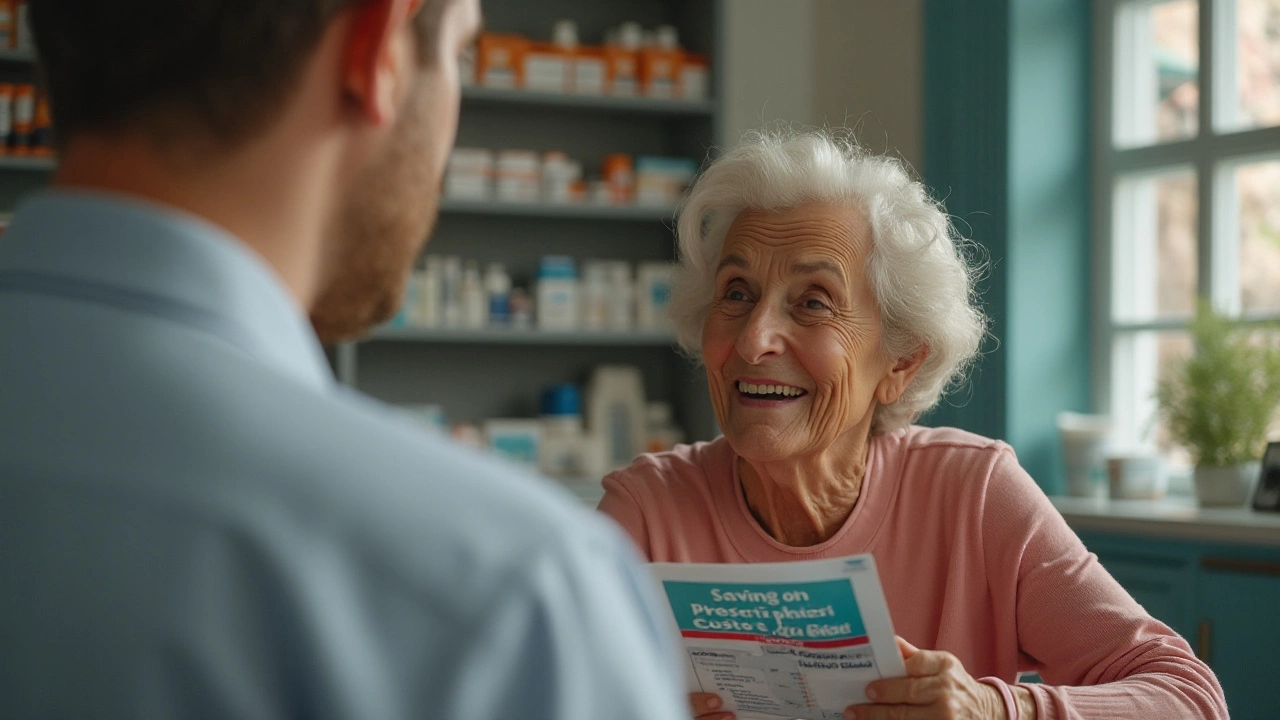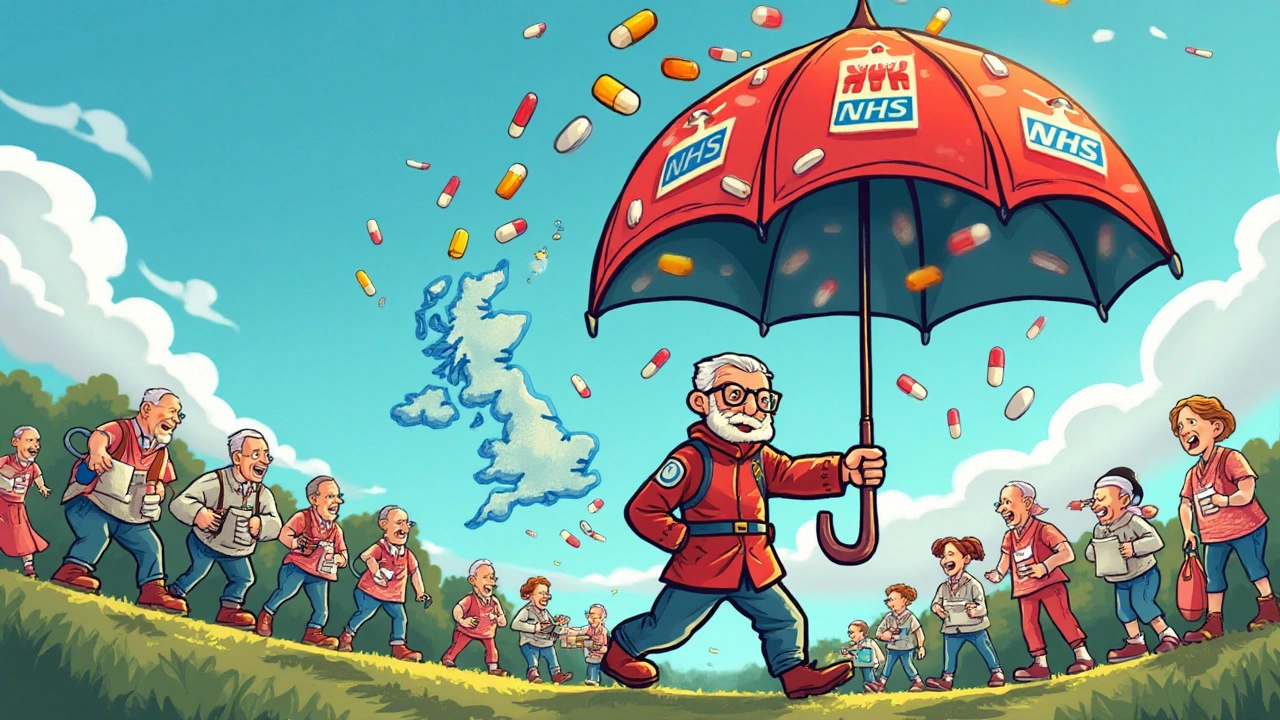 Jan, 31 2025
Jan, 31 2025
For many seniors, managing the costs of prescription drugs is a critical part of maintaining their health on a fixed income. With the rising prices of medications, it's no surprise that older adults often find themselves stretched thin, struggling to afford the prescriptions they desperately need. That's where the concept of a prescription drug cost cap comes into play.
This cap aims to put a lid on the out-of-pocket expenses seniors face when filling prescriptions, offering a safety net that prevents overwhelming financial strain. But how does this system actually work, and what does it mean for those relying on such measures?
In this article, we're taking a closer look at the intricacies of prescription drug cost caps. We'll dive into how they're structured, the benefits seniors can reap, and even some insider tips on stretching healthcare dollars further. Join us as we shed light on an essential topic that could make a world of difference in medication affordability for seniors.
- The Need for a Prescription Drug Cost Cap
- How the Cost Cap Works
- Benefits for Seniors
- Strategies to Maximize Savings
- Future of Prescription Drug Pricing
The Need for a Prescription Drug Cost Cap
With an aging population increasingly reliant on medications to manage chronic conditions, the financial burden of prescription drugs for seniors has reached critical levels. For many, affording essential medications is a balancing act between their health needs and their financial limitations. The cost of drugs continues to rise at a pace that outstrips inflation, putting seniors, many of whom live on fixed incomes, in a precarious position. Imagine having to choose between paying for medication or other basic necessities like food and utilities; for far too many older adults, this is a harsh reality.
The prescription drug cost cap is a measure designed to alleviate this pressure, setting a maximum limit on what seniors can be charged out-of-pocket for their prescriptions. This intervention is essential to prevent the further exacerbation of health disparities among older adults. Without such caps, seniors could face financial ruin from medication costs alone, a situation no one should endure. Evidence from healthcare studies suggests that limiting out-of-pocket expenses leads to better health outcomes, as patients are more likely to adhere to their prescribed treatments when they can afford them. An article from the New England Journal of Medicine once noted, "Affordable access to medications is crucial for maintaining the well-being of an aging population, reducing the risk of complications arising from unmanaged chronic diseases."
Another compelling reason for implementing a drug cost cap is the potential impact on societal costs. Unmanaged health conditions due to unfilled prescriptions can lead to higher rates of hospital admissions and emergency room visits, driving up healthcare costs for everyone. By ensuring seniors can afford their medications, we not only protect the health of our elders but also create a positive ripple effect on the healthcare system as a whole. Governments and policymakers recognize this and are increasingly under pressure to implement more extensive caps as both a compassionate and economical choice.
A look at international models offers insights into effective implementations. Countries with robust systems often see lower rates of financial hardship among seniors needing medications, revealing a clear correlation between drug affordability and health stability. With a growing awareness of these issues, there's a movement toward not just establishing caps but also periodically revisiting them to ensure they stay in line with current economic conditions and pharmaceutical advancements. Consider the words of healthcare economist David Dranove: "Prescription caps are more than barriers; they are gateways to proactive health management for our elderly citizens."
In moving forward, it's crucial to have a conversation about balancing the interests of pharmaceutical companies and the affordability of medications for seniors. Providing options such as generic drugs, negotiating prices, and fostering transparency in drug pricing models can enhance the effectiveness of cost caps. There is an imperative need for continued dialogue and action among stakeholders, including governments, healthcare providers, and patient advocates, to ensure that these measures are not only sustainable but also evolve in response to new challenges.
How the Cost Cap Works
The concept of a drug cost cap for seniors is not just about limiting expenses; it's about ensuring stability and predictability in healthcare budgeting for older adults. This initiative was born out of an increasing awareness of the burdensome costs seniors face when it comes to essential medications. To keep healthcare financially manageable, the government, along with several healthcare organizations, has introduced this cap as a part of a broader healthcare reform. Essentially, this means setting a maximum limit on what seniors have to pay out-of-pocket annually for their prescriptions. By doing so, it eliminates those stressful, sometimes impossible, financial decisions of choosing between vital medications and other basic needs.
The mechanics of the cost cap revolve around a seamless integration of insurance coverages like Medicare with supplementary private options. Once seniors reach a specific spending threshold each year on covered medications, additional purchases are either substantially discounted or fully covered. This means that the policy kicks into effect at varying rates, depending on an individual's health insurance plan. The cap is designed carefully to ensure it doesn't compromise the incentives for pharmaceutical innovation by fairly distributing financial responsibilities between the government, insurers, and patients themselves.
According to a recent report by the Department of Elderly Affairs:
"Implementing a prescription drug cost cap has significantly improved medication adherence rates among older citizens, as they no longer feel financially deterred from following prescribed regimens."This quote highlights how stayed course with their medications rather than skipping doses due to cost concerns. Not only does this cap alleviate immediate fiscal pressure, but it also contributes to longer-term healthcare savings by preventing complications that arise from neglected medical prescriptions. By leveraging both public and private partnerships, the system maintains a balance between affordability and the economic sustainability of the healthcare industry as a whole.
Patients and their families should regularly keep track of prescription expenses throughout the year. To fully benefit from the prescription cost cap, seniors should be aware of the list of covered medications under their plan. This awareness can guide their discussions with healthcare providers, which helps align prescriptions with personal financial strategies. There's also a growing trend of digital tools and apps that assist seniors in budget planning for medications, which can be particularly effective when used alongside these caps. The marriage of technology with healthcare management means seniors are better equipped to navigate their medication needs in a financially savvy way.
Here’s a look at how prescription drug cost cap structures often pan out for seniors enrolled in standard Medicare plans:
| Medicare Coverage Phase | Senior's Out-of-Pocket Expenditure | Cap Status |
|---|---|---|
| Initial Coverage | Up to $4,130 | Payments contribute to reaching the cap |
| Coverage Gap | $4,130 to $6,550 | Beyond the gap, prescription expenses sharply decrease |
| Catastrophic Coverage | Over $6,550 | Significantly reduced costs up to annual cap |
To wrap this up, while the blueprint for how a drug cost cap functions can seem technical, its principle is rather straightforward — ensuring access. With the looming trends of a growing elderly population yet limited pension growth and resources, having a practical and effective cost management system is not just smart, but necessary. Empowering seniors with medications at manageable prices ensures they live healthy and fulfilling lives. It's those life-enhancing benefits that make understanding and utilizing the drug cost cap invaluable for today's older adults.

Benefits for Seniors
The prescription drug cost cap offers a plethora of advantages, particularly for seniors who are often grappling with the financial complexities of managing medical expenses on a fixed income. This economic safeguard not only ensures that out-of-pocket expenses don't exceed a specific limit but also helps seniors maintain access to vital medications. By capping these costs, the policy helps to alleviate some of the financial strains that can accompany age-related health issues. It's a relief to many who are reliant on regular medications for conditions like hypertension, diabetes, or heart disease, where missing doses due to cost concerns could lead to severe health repercussions.
With the advent of this cost cap, seniors no longer need to choose between essential medications and other basic needs. This is particularly important in today's economy, where the prices of many goods and services are on the rise. The cap provides a significant psychological relief, removing the continuous worry about skyrocketing medication costs and allowing seniors to plan their finances with a bit more predictability. By setting a firm limit on expenses, it enhances financial stability and ensures that seniors won't be hit with unexpected medical bills that could jeopardize their monthly budgets or drain their savings.
One of the substantial direct benefits of the prescription costs cap is medication adherence. Studies have shown a direct correlation between cost-related non-adherence and poor health outcomes. When seniors can afford their medications consistently, they are more likely to adhere to prescribed regimes, reducing hospital admissions and emergency room visits. Increasing accessibility to affordable medication bolsters health outcomes and enhances the overall quality of life for older adults. A quote from a Healthcare Finance Analysis report succinctly captures this idea:
"The introduction of drug cost ceilings shows a tangible decline in health deterioration due to non-adherence in the senior population."
Additionally, the implementation of this cap can bring about a more vibrant healthcare marketplace. When prices are contained, competition tends to increase among pharmaceutical companies, leading to more innovation and better options for consumers. For seniors, it means access to a broader range of treatments and therapeutic medications without the anxiety of financial ruin. This competitive environment fuels advancements in medication research and also paves the way for less dependency on higher-priced brand names, potentially opening doors to more cost-effective generic options.
Furthermore, by alleviating the financial burden, seniors may find themselves with additional disposable income that can be allocated to other important aspects of their lives, whether it's pursuing hobbies, spending time with family, or investing in activities that promote mental and physical health. By cutting down on healthcare savings stress, seniors gain an improved ability to enjoy life, fostering a sense of independence and dignity in their golden years.
Social and Economic Impacts
This cap isn't just about individual benefit; it resonates with significant socio-economic positives as well. By ensuring that seniors can afford seniors their medications, healthcare systems experience decreased strain from preventable illnesses; thus, more resources can be funneled into treating acute and chronic conditions effectively. On a broader scale, when seniors maintain their health and quality of life, the ripple effect touches their families and communities, nourishing a more robust societal fabric.
Strategies to Maximize Savings
In today's world, where healthcare costs seem to only go up, keeping prescription expenses under control is more important than ever, especially for seniors. There are numerous tactics that seniors can employ to ensure they don't break the bank while aiming to afford their essential medications. One key strategy is to do a little bit of research on generic drugs. Many brand-name medications have generic counterparts that contain the same active ingredients and offer the same therapeutic benefits. These alternatives can be significantly cheaper. Not only do they help in reducing the immediate pharmacy bill, but they also make it easier for seniors to keep up with their medications without hesitating when it's time to get a refill.
Another important tip is to review insurance options frequently. Many don't realize that plans change from year to year, and the insurance coverage that worked well one year may not be the best fit the next year. Seniors should sit down and compare their current insurance with others available in the market. Look closely at what's covered and determine which plan offers the best deal on prescription drugs. Remember, being proactive can save quite a bit of money. Also, don't shy away from talking to the healthcare provider about prescription cost burdens. Open communication can lead to surprising solutions, like prescribing different, less expensive medications or offering information about pharmaceutical assistance programs.
Using Technology to Your Advantage
Technology is another ally in the quest to keep prescription drug costs in check. Price comparison apps and websites are a great tool. They allow users to compare prices of drugs across different pharmacies in the area. Often, pharmacies will have varying prices for the same medication, and a few taps on an app might lead to significant savings. Additionally, mail-order pharmacies often provide discounts for purchasing in bulk or for using an automatic refill feature. Not only does this mean lower costs, but it also means fewer trips to the pharmacy, which can be a win-win scenario for many seniors."It is wise for patients to have a frank discussion with their healthcare providers about the financial implications of their medications. This dialogue can often unearth surprising opportunities for savings." — Dr. Elizabeth M. Lauderdale, Healthcare Advocate
Moreover, don't underestimate loyalty programs offered by pharmacies. Many pharmacies reward regular customers with discounts or cash-back offers on future prescription purchases. While such savings might seem incremental at first, they can accumulate significantly over time. Finally, consider participating in health clinics and community events that occasionally offer free medication samples or coupons. These are excellent opportunities to learn about cost-saving measures directly from healthcare professionals. Remember, the best approach combines several small strategies, each chipping away at the total expense. By being diligent and informed, seniors can retain access to necessary medications while keeping a tighter rein on their spending.

Future of Prescription Drug Pricing
As we gaze into the future of prescription drug pricing, it's evident that the healthcare landscape is ripe for transformation. Technological advancements, policy shifts, and demographic changes are set to play pivotal roles in shaping how medications are priced and accessed. For seniors, understanding these trends is crucial as it directly impacts drug cost cap policies and out-of-pocket expenses. Innovations like personalized medicine derived from genomic data are poised to influence drug development; this could potentially lead to more targeted therapies and, hopefully, reduced waste and lowered costs as ineffective treatments dwindle.
However, the journey is not without hurdles. Pharmaceutical companies, navigating complex regulatory frameworks, face pressures to maintain profitability which can drive prices upwards. Amid this, policy leaders are advocating for more transparency in how drugs are priced. The call for transparency centers on detailing the research and development costs, pricing markups, and the overall impact on insurance premiums. Interestingly, a report from XYZ Healthcare Journal noted that over 60% of the public favors regulation to limit price increases, reflecting a growing demand for governance in the pricing process.
According to Dr. Amanda Chen from the University of Wellington, "Future drug pricing will heavily depend on the balance between innovation incentives for pharmaceutical companies and the need for equitable access to medicines."
Beyond pricing policies, demographic trends are equally significant. With an aging population, especially in nations like New Zealand, the demand for prescription costs management will increase dramatically. This growing segment of the population could lead to increased political pressure to sustain and enhance drug cost cap initiatives. Initiatives focusing on alternative funding models, such as subscription-based payment systems where a set monthly fee covers all required medications, are being piloted in select areas. These could revolutionize how seniors access drugs, ensuring cost predictability.
Finally, it's essential to consider international influences. The globalization of the pharmaceutical industry means that trade agreements, particularly post-COVID-19, will affect drug pricing structures. Nations are likely to form coalitions to negotiate bulk purchasing, driving costs down on essential drugs. Such strategies, combined with domestic policy reforms, hold the potential for meaningful shifts in the pricing paradigm.
Despite these possible changes, what remains constant is the need for seniors to stay informed. By understanding these evolving dynamics, they can better advocate for their interests and navigate the complexities of healthcare systems. Through collaboration between government bodies, pharmaceutical companies, and the end-users themselves, the future of prescription drug pricing can be shaped toward a fairer, more sustainable model for all.
